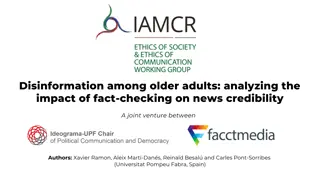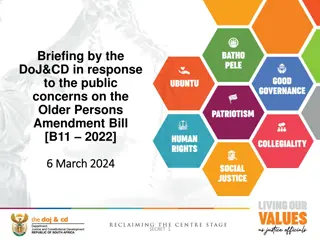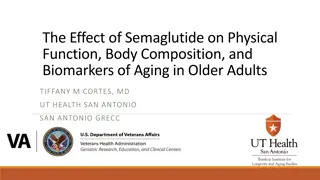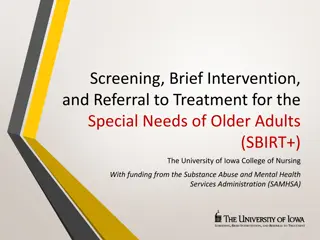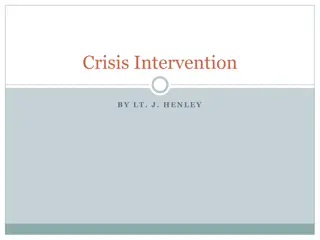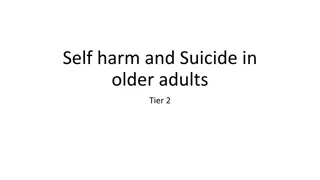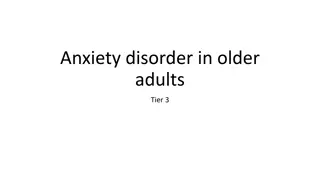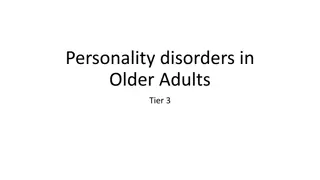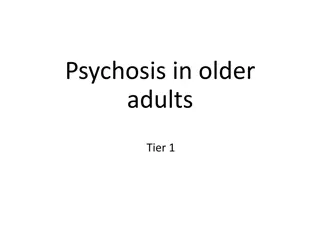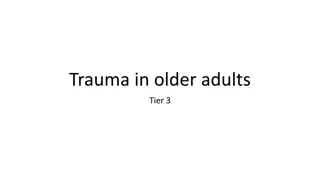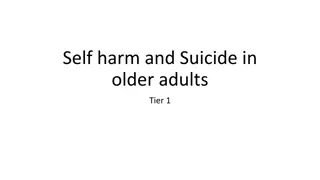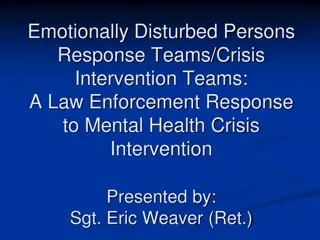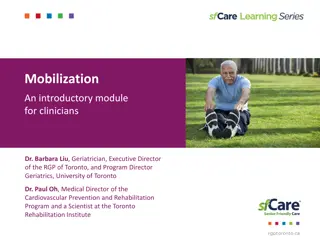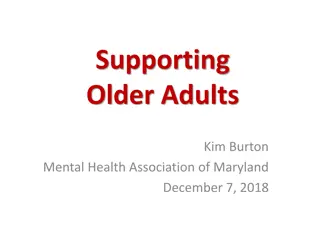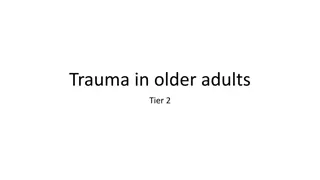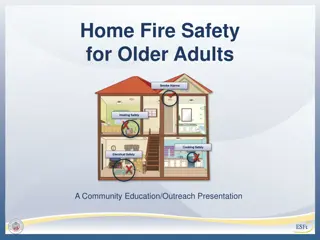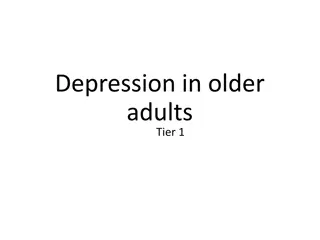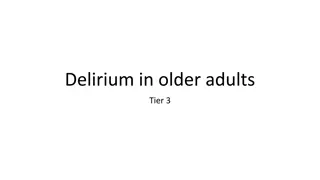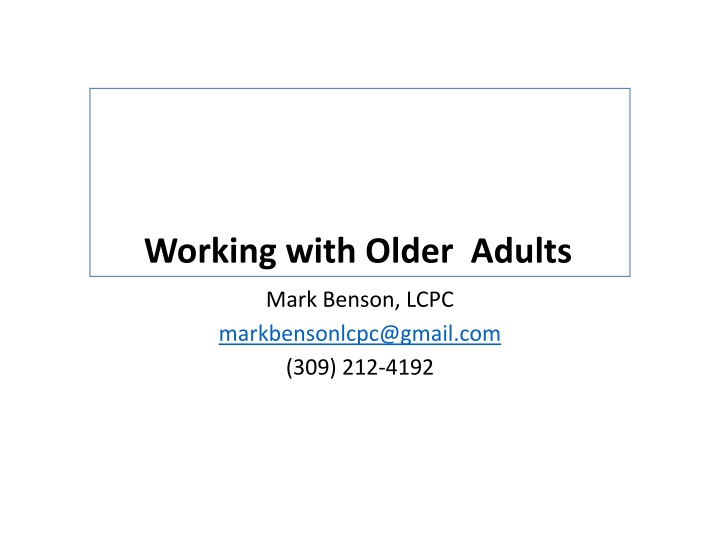
Aging: Psychological & Physical Changes in Older Adults
Explore the psychological and physical changes associated with aging in older adults, covering topics such as mental health issues, cognitive impairments, substance use, elder abuse, and more. Gain insight into the generativity versus stagnation and integrity versus despair stages of development, along with common concerns like depression and Alzheimer's disease.
Download Presentation

Please find below an Image/Link to download the presentation.
The content on the website is provided AS IS for your information and personal use only. It may not be sold, licensed, or shared on other websites without obtaining consent from the author. If you encounter any issues during the download, it is possible that the publisher has removed the file from their server.
You are allowed to download the files provided on this website for personal or commercial use, subject to the condition that they are used lawfully. All files are the property of their respective owners.
The content on the website is provided AS IS for your information and personal use only. It may not be sold, licensed, or shared on other websites without obtaining consent from the author.
E N D
Presentation Transcript
Working with Older Adults Mark Benson, LCPC markbensonlcpc@gmail.com (309) 212-4192
Overview Review Bio/psycho/social changes in aging Address mental health issues with older adults Identify and address cognitive impairments Substance use and misuse Elder abuse and self-neglect Applying this to CIT
This Generation 75 y/o ~ born in 1946 85 y/o ~ born in 1936 WHAT have they seen and lived through? WHERE are they now?
Aging: Physical Graying/loss of hair Skin thinning, dryness, pigment changes Vision decreased acuity, cataracts, glaucoma, macular degeneration Sleeping Patterns- more difficulty falling and staying asleep Brain shrinks causes some memory impairment Bone loss, decrease in muscle mass, joint problems Vascular changes thicker heart muscle and artery walls Metabolism slows- decrease in energy levels Sensory changes- hearing, smell, touch, taste
Aging: Psychological Erik Erickson s Psychosocial Stages of Development Generativity vs Stagnation During the ages of 40 to 65 (generally speaking), psychologically healthy individuals seek to make their mark and contribute willingly to society to increase our sense of community. This way, our actions leave an impact on those who come after.
Aging: Psychological Erik Erickson s Psychosocial Stages of Development Integrity vs Despair Frequently after age 65, people recognize they are reaching the end of their life and look back on their past experiences to judge whether they accomplished their life goals, and if their lives had any meaning or purpose. (https://www.simplypsychology.org/Erik-Erikson.html)
Most Common Concerns of Older Adults Depression Agitation Thought disturbance /Perceptions Alzheimer s Disease /Dementia Substance Abuse/Medication Misuse
Depression Often missed or untreated Approximately 10% of people over 65 are treated for depression Symptoms are sometimes dismissed as crankiness, grumpiness or part of the normal aging process Mood changes and other signs of depression can be caused by medications
Depression: Triggers Physical Illness Dementia Bereavement/Grief Environmental/ Care giving Stress and Conflict with Adult Children Substance Abuse
Older Adult Suicide Facts 12.5% of the population is over 65. Account for 18% of all suicides The suicide rate for adults >75 is 3X higher 75% of older adults who complete suicide saw their primary physician within the last month White men over 55- highest rate of suicide Make less attempts, but are more likely to die from an attempt
Suicide: Risk Factors Experienced the death of a loved one Illness Isolation Role change Divorce/Widowed Financial Family history of suicide
Agitation Confused with anxiety but commonly seen in anxious persons An inappropriate verbal, vocal or motor activity, not an obvious expression of need repetition Not a diagnosis but a group of symptoms
Signs of Agitation Extreme Irritability Anger Fidgeting Racing Thoughts Restlessness Pacing Hand-wringing Nail-biting Verbal Outburst Pulling at clothes or hair Taking clothes off Picking at Skin
What Exacerbates Agitation? Fatigue Over stimulation: music, loud noise Crowds Unfamiliar places Co-Morbid illnesses Demands above the person s abilities Medication misuse Traumatic Events Anxiety Disorders
Content of Thought Disturbances of Perception Hallucinations: Can impact 15%-50% of adults with dementia Delusions False fixed beliefs, often negative and persecutory in nature, especially in Dementia (20-75%) Five Types: People are stealing items (18-43%) Misidentifications (This house is not mine) Spouse, family or familiar person is an imposter Abandonment (3-18%) Infidelity (1-9%)
Medication Misuse Older adults consume an average 2-6 prescription medications per day and 1-3 OTC medications per day About of drugs prescribed for older adults include some form of sedative Misuse can be intentional or unintentional Multiple doctors Confusion Cognitive Impairments Use of alcohol or other drugs Financial difficulties SAMSHA
Substance Use As we age the body s ability to absorb and dispose of medications, alcohol and other drugs changes Substance use and medication misuse: Often mistaken for dementia, depression or other problems common to older adults Belief taking more medications / vitamins / supplements will improve quality of life. Use of alcohol in older adults may increase the likelihood of drug interactions and raise blood alcohol levels more quickly
Substance Use CDC: Adults 65 and older are more likely to engage in binge drinking than younger adults Older Adults experience effects of alcohol more quickly Increase risk for falls or unintentional injuries Estimated 17% of older adults are affected by alcohol and prescription drug misuse and overuse
Early Stage Alzheimers Difficulty with tasks such as balancing a checkbook or making dinner Difficulty learning new tasks Slower reaction time when driving or making decisions Aphasia (difficulty finding words to use in conversation) Short term memory loss Increased irritability, anxiety, or feelings of depression Social withdrawal Often aware of these changes
Moderate Stage Alzheimers Significant personality changes, such as being argumentative, impulsive, angry Resistant to, or combative with, physical care provided by others Short-term and long-term memory loss Increased difficulty in communicating with others Potential for wandering away from home Very poor judgement and lack of decisional capacity Possible incontinence Possible paranoia, hallucinations, or delusions
End Stage Alzheimers Decreased ability to interact with others Diminished ability to recognize people Flat affect Extremely poor motor function and spatial awareness Limited or no speaking ability Difficulty with eating, even with assistance Apparent withdrawal from surroundings Incontinence Final stage: body begins to shut down as the brain loses the ability to regulate organ systems
Review Alzheimer s Disease is progressive Dementia is an umbrella term; there are many types of dementia including Alzheimer s Disease There are no known causes or cures; only medications to help minimize the symptoms Cognitive loss includes changes to memory, reasoning, communication, personality, behavior, judgments and decision making Easily becoming lost and wandering are common behaviors with adults with dementia
Wandering 6 in 10 adults with dementia will wander An adult with dementia may not remember his or her name, address. May become disoriented in familiar places
Silver Search 1/1/2016- Illinois passed legislation to create a coordinated effort to bring education, awareness, and resources to assist in safely returning individuals with dementia that go missing Goal is to quickly disseminate information about a missing or endangered person to the public Silversearchillinois.org
Endangered Mission Person Advisory Criteria Missing person is under unexplained or suspicious circumstances Person is believed to be in danger due to age, health, mental or physical disability, environment, weather conditions or in the company of a potentially dangerous person of some other factor that may expose the person to possible harm or injury Does not meet the criteria for an AMBER alert
Validation Don t confirm or deny frame of reality Remember behaviors may reflect a need; trying to discover this need may be very helpful in how one chooses to validate Example: a demand to go home may be a reference to a desire to feel safe and secure rather than a physical location Validate by repeating a concern, and when possible, express personal agreement with the concern to showcase empathy
Redirection Redirection to a conversation with a similar topic Allows for a natural transition May need to gradually steer the conversation towards a new subject Often helpful to have some redirection ideas planned in advance Provide validation of feelings (sad, anxious, mad) Reassurance before redirection- shows understanding of the concerns, prompts cooperation
Compassion/Empathy Treat as you would want your parent to be treated Allows the person to feel respected/validated Increases feelings of safety Increases hope/optimism
Interaction Tips Make eye contact Address the person by name Use short, simple words and sentences Monitor body language and non-verbal cues Stay calm Don t take behaviors personally Never argue or insist Be positive, focus on what they can do, not what they can t If ambulatory, walk to reduce adrenaline Seniors may need more time to process information
Interaction Tips Limit distractions/overstimulation Use humor when appropriate Make sure a neighbor or friend are aware of the situation Focus on safety and solutions Use touch and hugs to connect emotionally Encourage nonverbal communication, such as body language (pointing, thumbs up, head nodding, etc.) Be respectful, in every situation
Interaction Tips Assume the older adult is cognitively intact unless you are given clear reason to question this Gain trust . You don t know their history with law enforcement Alterations in the mental status often due to physical illness Look for changes in appearance & behavior, speech, general motor activity, mood, posture/gait Obtain input from someone who knows the senior s normal baseline
Interaction Tips Look for medical alert bracelets Talk directly to the senior- Eye contact Don t talk down to them as if they were a child Acknowledge their frustration DON T argue reality Repeat, repeat and repeat Limit open-ended and memory questions Keep the atmosphere calm Move the senior to an area of less stimulation
Interaction Tips Remember persons with Dementia / Mental Health impairments are easily abused, exploited and taken advantage of. Multiple calls concerning the same victim may not all be unfounded .look for hidden clues Minimizing Excuses Environmental concerns Abusive behaviors toward the victim by friends/ family members in your presence
Adult Protective Services Act Adult Protective Services Act 320 ILCS 20/1 et seq.: Allows Illinois Department on Aging to investigate abuse of seniors or adult with a confirmed or suspected disability in a community setting. Alleged abuse, neglect or financial exploitation of persons > 60 years old and adults with disabilities Promotes investigation, intervention and follow-up services Reporters of abuse, neglect and exploitation are immune from criminal or civil liability or professional disciplinary action Reporters are anonymous (except with the written permission of the reporter or by order of a court)
Adult Protective Services APS Social Services Program with the goals to: Investigate reports of alleged abuse Intervene to prevent further mistreatment Allow a person to remain independent to the maximum degree possible. APS Goal: Keep the person safe and independent in their home environment APS 24 Hour Hotline: 1-866-800-1409
APS: Process Intake: Contact APS 24/7 to provide intake information Assessment: Initiated within 24 hours or up to 7days 30 days to complete the assessment Follow up: Case can be kept open for up to 15 months Additional time can be added APS 24 Hour Hotline: 1-866-800-1409
Power of Attorney and Guardianship Power of Attorney broadly refers to one's authority to act and make decisions on behalf of another person in all or specified healthcare, financial or legal matters. The power of attorney can be changed at anytime as long as the person retains some capacity to understand. Guardianship is a court action appointing someone to make decisions for you when you become incapable of making your own decisions due to an illness or when an incapacity endangers your health or safety
Abuse: Definitions Physical abuse is the use of force to threaten or physically injure a vulnerable adult Emotional abuse is any form of verbal attacks, threats, rejection, isolation, or belittling acts that cause or could cause mental anguish, pain or distress to a vulnerable adult Sexual abuse is any sexual contact that is forced, tricked, threatened, or otherwise coerced to a vulnerable adult Exploitation is any form of theft, fraud, misuse or neglect of authority, and use of undue influence as a lever to gain control over a vulnerable person s money or property
Signs of Abuse Bruises, slap marks, pressure marks Burns or blisters Unexplained sexually transmitted disease Withdrawal- unexplained change in alertness Sudden change in finances and accounts, altered wills and trusts, unusual bank withdrawals, checks written as loans or gifts , and loss of property Bedsores, need for medical or dental care, unclean clothing, poor hygiene, overgrown hair and nails, unusual weight loss Be aware of statements that minimize potential for harm or explain away an apparent injury or impairment
Abuse Definitions Neglect: Failure or refusal to provide for a vulnerable adult s safety, physical, or emotional needs. Both Passive and Willful Willful Deprivation: Willfully denying a vulnerable adult medication, medical care, food, shelter or other physical assistance Confinement: Restraining or isolating a vulnerable adult for other than for medically appropriate reasons
Other Concerns Self-neglect: Behavior of a Vulnerable Older Adult or Vulnerable Person with a Disability Who is not able to make appropriate decisions or understand consequences for their own actions Behavior substantially threatens own health and safety including the inability to provide for own basic needs and personal hygiene, which may lead to harm or endangerment
APS Providers for Area 5 Family Service Senior Resources of Champaign County 405 S. State Street Champaign, IL 61820 217-352-5100 Counties Served: Champaign and Piatt Care Horizon 304 North Maple Urbana, IL 61802 Care Coordination: Champaign, DeWitt, Douglas and Piatt 217-384-3360
APS Providers for Area 9 Swan- Stopping Woman Abuse Now 115 S. Maple Salem, IL 62881 618-740-0898 Counties Served: Fayette, Effingham, Marion, Clay and Jefferson Care Coordination: Effingham City/County Committee on Aging- Senior Services of Fayette County 618-283-4122
APS Providers for Area 10 SWAN (Stopping Woman Abuse Now) 1114 S. West Street Olney, IL 62450 618-392-3556 Counties Served: Jasper, Crawford, Richland, Lawrence, Wayne, Edwards, Wabash, Hamilton and White Care Coordination: Effingham City/County Committee on Aging- Senior Services of Clay County. 618-662-7304
Final Thoughts Don t judge All people want to retain their dignity, even when their bodies and minds are failing Be respectful Everyone has a story Acknowledge changes in the lives of seniors People around them Their role in life and society Sensory changes Loss of independence and choice Financial

